Apple's iPhone 4: Thoroughly Reviewed
by Brian Klug & Anand Lal Shimpi on June 30, 2010 4:06 AM EST- Posted in
- Smartphones
- Apple
- iPhone 4
- Gadgets
- Mobile
Performance
When the 4 was announced, my curiosity (and perhaps yours as well?) was about the flavor of Apple’s A4 SoC inside the phone. The rumor was that the A4 in the iPhone 4 had a full 512MB of memory, compared to 256MB in the iPad’s A4. iFixit took an iPhone 4 apart (with relative ease I might add) and confirmed the presence of 512MB. Look at the A4 in this picture, the Samsung part number on the right edge of the chip starts out K4X4G. The K4X denotes a Samsung mobile DRAM and the 4G refers to its density: 4Gbit or 512MB.
More memory should mean a smoother multitasking experience on the iPhone 4. Remember that iOS 4 keeps all fast task switching enabled apps resident in memory even after you’ve switched away from them. They are only kicked out of memory if you run low or if you force quit them. With more memory you should be able to keep more apps in memory without unwillingly forcing them out. The 512MB of RAM should also give the OS more breathing room in lighter multitasking scenarios, a problem many are already seeing on the iPhone 3GS running iOS 4. In practice the 4 is smoother when running iOS 4. There are still some hiccups but not as bad as on the 3GS, and definitely not as bad as on the 3G. The OS was clearly designed with the iPhone 4 as the performance target.
The big question that remains is what clock speed the iPhone 4’s A4 is running at. The assumption was 1GHz however Apple was very careful not to mention clock speed, unlike at the iPad launch. Saying nothing usually means there’s nothing good to say.
I ran a whole bunch of benchmarks on the iPhone 4 and the iPhone 3GS running iOS 4 to try and figure out what CPU speed we might be dealing with. The early reviews imply that the A4 in the iPhone 4 is running at a speed greater than the 3GS’s 600MHz, but slower than the iPad’s 1GHz. Let’s try and find out what it’s really running at.
We’ll start with the real world tests, first SunSpider. A javascript performance test this benchmark is completely network independent but it measures the performance of the browser as well as the underlying hardware. It is small enough to make memory size differences negligible so between the two iPhones we should be seeing a pure CPU comparison:
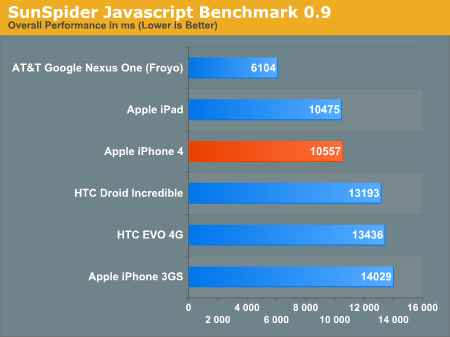
The iPhone 4 manages a time that’s 25% faster. Note that this test is just as much about the software stack as it is about CPU/platform performance. The Froyo update makes the Nexus One ridiculously fast in this benchmark. It just shows you how much room there is to improve performance on these Android handsets. The next leapfrog is going to be once the entire Android world moves to 2.2.
Next up is the Rightware BrowserMark. This test combines JavaScript and HTML rendering performance:
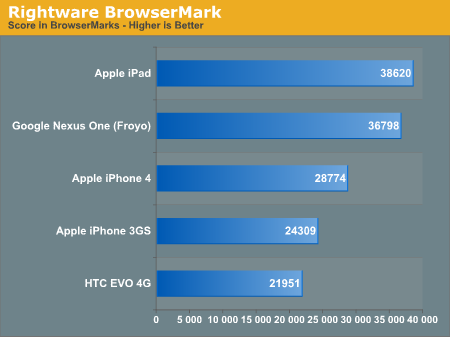
BrowserMark spits out an overall score but with no indication of what the score actually means. In this case we’re looking at 18.4% better performance than the iPhone 3GS. The iPad is 34% faster than the 4, which supports the theory of the A4 running at ~750MHz in the new iPhone.
There's also the possibility that the A4 CPU clock varies depending on load and other factors but the run to run consistency in all of our tests seems to indicate otherwise. We also can't ignore the fact that the iPad and iPhone now run vastly different OS revisions. In some cases iOS 4 actually takes a step back in performance compared to iOS 3.2. That undoubtedly makes the iPad vs. iPhone 4 comparison about much more than CPU performance.
Froyo's improved Javascript performance sends the Nexus One nearly to the top of the list here, only bested by the iPad. While Apple has definitely improved performance with the iPhone 4, it seems that it will only take a software update for Android phones to surpass it.
To measure web browsing performance I downloaded a bunch of different web pages and saved as much of them as possible locally on a server. I used WiFi on all of the devices to connect to my local server and timed average load time. I repeated the test at least 3 times and threw out any unusually high or low numbers. Performance was from a clean restart with no additional programs running in memory.
Note that these numbers aren't comparable to other reviews as we've updated software versions on two of the phones. The iPhone 3GS is now running iOS 4 which resulted in some numbers going up while others went down. And the Google Nexus One is running the officially released build of Android 2.2, codenamed Froyo.
What these tests should show is the overall performance of the platform when all network bottlenecks are removed. Obviously hiding in a tunnel under a lead umbrella will make any phone slow, but we’re looking at peak performance here.
The first test is the new AnandTech front page. Here we’ve got tons of images and HTML, meaning we’re stressing both bandwidth and code parsing speed.
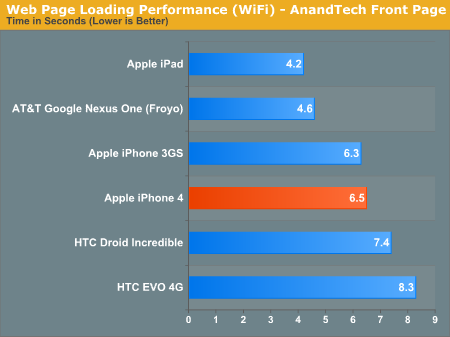
The iPhone 4 is no faster than the 3GS (actually slightly slower, but we'll chalk that up to timing variance) here. The Froyo update to the Nexus One makes it lightning quick, almost as fast as the iPad in our first test.
Next up we have the first page of our recent Zotac XBOX HD-ID11 review. The balance shifts from tons of images to more HTML processing:
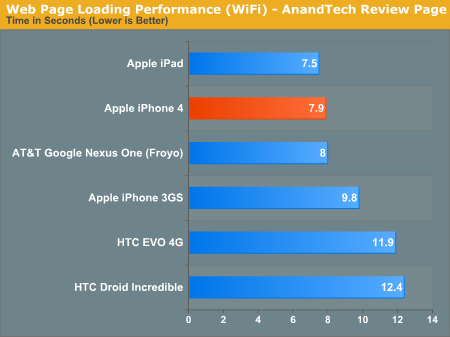
Here we see more of what I expected: the iPhone 4 is around 25% faster than the 3GS running iOS 4. Android 2.2 running on the Nexus One is basically as fast as the 4.
Using our Print this Review function, this next test loads our entire 2010 15-inch Macbook Pro review. While the other two tests had some flash ad content, this one is completely devoid of it so the HTC phones shouldn’t be penalized:
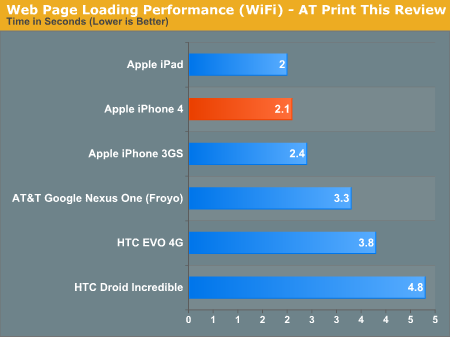
Here the iPhone 4 is 11% faster than the 3GS and about the speed of the iPad. There are other bottlenecks at play here so we don't get further performance scaling. The Froyo update helps the Nexus One a bit but the iOS devices are still quicker.
Our most intensive test is up next with a load of the Engadget front page:

The Nexus One is ahead of the 4 once more with its Froyo update. And the iPhone 4 is 34% faster than the 3GS.
Our most CPU bound test is up next. I put together a custom page with a ton of tabular content and a single page copy of our 15-inch MBP review to make the load take some time at least.
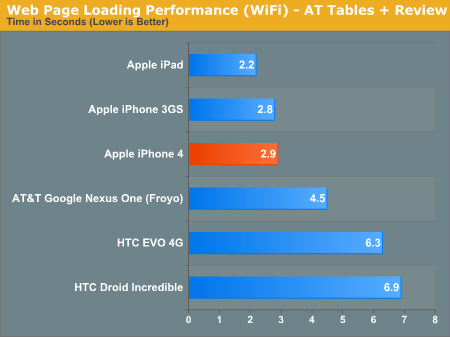
Surprisingly enough there's no difference between the 3GS and the 4 here, perhaps my test is less CPU bound than I thought. Froyo improves the Nexus One's performance a little bit.
Low Level Synthetic Tests
If we assume that we’re mostly CPU bound in all of these cases (a fair assumption given how fast Atom can run through all of these tests), then we’d be looking at a ~750MHz clock speed for the iPhone 4’s A4 assuming no other architectural changes. That’s actually a pretty big assumption. The A4 is widely believed to be a 45nm SoC using an ARM Cortex A8. At 45nm there should be room for a larger L2 cache than what was used in the iPhone 3GS’s SoC.
Perhaps some more synthetic tests will help us figure out what’s going on. I turned to Geekbench, now available in an iOS version.
Geekbench spit out a number of overall results that gave me a good enough summary of what’s going on to make an educated guess:
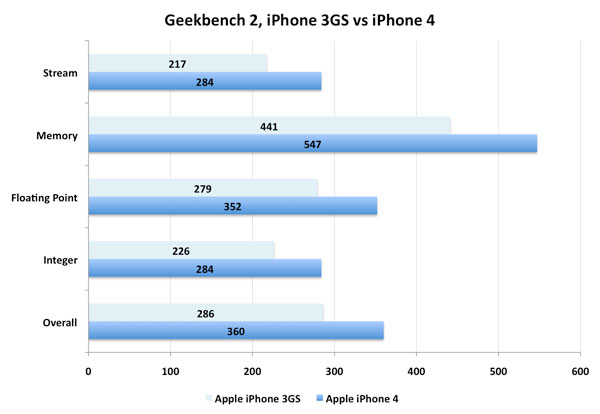
The CPU specific tests all indicate the iPhone 4 is around 25% faster than the iPhone 3GS. That would imply at least a 750MHz clock speed if all else is the same. Assuming we don’t get perfect CPU scaling with all of these tests, I’d venture a guess that 800MHz is more accurate. If the A4 does indeed have larger caches however, Apple could get away with a lower clock speed.
The memory results are particularly telling as they all scale very well going to the iPhone 4, better than the CPU results in fact. This could lend credibility to the theory of larger internal caches or perhaps to an improved (faster) memory subsystem.
Unfortunately until we get the iPad on iOS 4 we can't get a better idea of CPU scaling. I'm not even sure how reliable that will be at this point. If Apple was willing to change the amount of memory the A4 package housed between the iPad and iPhone 4, who is to say that it wouldn't have a slightly different design for the iPhone 4 (e.g. larger caches). The designs may not be physically different but we may instead be looking at binning. Given Apple's unwillingness to talk about the architecture here I think the safest bet is that we're looking at an 800MHz ARM Cortex A8 core in the iPhone 4 and a 1GHz core in the iPad.
Why the lower clock? It's all about battery life.










270 Comments
View All Comments
Griswold - Wednesday, June 30, 2010 - link
Lets be honest, he has only very limited means to meassure the problem. To get to the bottom of this, it needs to be meassured in a HF lab.samspqr - Wednesday, June 30, 2010 - link
"The fact that Apple didn't have the foresight to coat the stainless steel antenna band with even a fraction of an ounce worth of non-conductive material either tells us that Apple doesn't care or that it simply doesn't test thoroughly enough."I find it really funny that they would never catch this specific problem because of them just being apple: if their engineers are not as good as anand is (as in thinking "that's gonna be a problem" right after hearing the description of the antenna), and if THE FIELD TESTERS HAD THEIR PHONES DRESSED AS A 3GS BECAUSE OF PARANOID ISSUES, this kind of problem can only slip through
The0ne - Wednesday, June 30, 2010 - link
I think Anand was a little light on this topic. As an multi-discipline engineer myself this type of problem with the Antenna SHOULD NEVER had happened. It can only happened due to decisions that did not properly address it. This is not rocket science to engineers. If anything, testing WOULD HAVE discover the problem and yet it's in the finish product. Quite sad if you ask me.For example, why put a ferrite clamp on the end of the cable instead of designing it into the PCB . The only reason I can see why we did this was due to lack of time and we severely paid for it by having products become defective because the ferrite would pull the cables loose from the connectors.
deppbv78 - Wednesday, June 30, 2010 - link
I'm really disappointed at the lengths taken by AT to justify that iP4 losing signal as not a big deal...If it was any other product from any other manufacturer, I'm sure you'd not have gone to such lengths to justify the signal drop and just concluded that the phone has serious antenna problems. I'm not understanding why is it so difficult for anyone just provide an unbiased view of the product.I have HTC Hero & Touch Pro both of which lost a bar or two (with fluctuations) when cupped tightly. However, it was always just 1-2 bars and never went down like iPhone 4 does from 5 bars to 0. This continuous loss of signal is the problem. Justifying it telling that all phones lose signal is not right, as every other phone (including 3GS) loses signal temporarily and then stabilizes unlike iPhone 4.
No wonder the iPhone 4 is engineering marvel, but that set aside it is also true that the design has created issues as well and the reviews need to acknowledge it and not justify it
geniekid - Wednesday, June 30, 2010 - link
HTC Incredible owner here. I think AT successfully showed that the antenna issue is NOT a big deal and their methods for doing so are sound. I share your suspicion that maybe they wouldn't have made such a significant investigation if it had been another phone, but let's not accuse them of mistakes they haven't made yet.bplewis24 - Wednesday, June 30, 2010 - link
I have a sincere question though. Does this test really successfully show the antenna issue is NOT a big deal, or does it simply show that it's not a big deal in the utmost ideal conditions?Sometimes the article is difficult to decipher in terms of understanding who is saying what, but upon my initial reading I take it Brian did the testing of the antenna in Arizona. By his own admission (from my understanding), he lives there because the reception is absolutely stellar and about as good as it can possibly be.
Again, from what I can tell, it is under those conditions that he conducted the attenuation signal loss comparisons. If it still drops down to 1 bar and comes reasonably close to dropping calls under the best possible conditions, how does it react under "average" conditions? Other people are reporting dropped calls for a reason. Is Brian's test the norm or an outlier?
Please correct me if I've read this article wrong.
Brandon
anactoraaron - Wednesday, June 30, 2010 - link
My understanding is you are partially correct in assuming (which is what I interpreted from your post) that under "normal" or "average" conditions you will go to one bar - which with the improved reception even at 1 bar you are still fine - OR will drop signal completely.This is also the reason why they say "At the bare minimum Apple should give away its bumper case with every iPhone 4 sold."
Again, fantastic in-depth review.
strikeback03 - Thursday, July 1, 2010 - link
Well, he said the location he lives in has stellar reception. But he also said he drove around for a day testing, which implies to me that he found somewhere with a stable, "average" signal and did some testing there, then probably went somewhere with a "poor" signal and did some more, etc.bplewis24 - Friday, July 2, 2010 - link
@strikeback03Correct. And in driving around to the less-than-stellar areas showed the phone dropping down below -107dB for reception when showing less than 2 bars. And this is on the low end of the reception spectrum as described earlier in the article. So it's pretty clear that the antenna does INDEED show poor signal strength in average or less than average areas when the "death grip" is applied.
That is the determining factor. That determines that the design is defective and flawed. If it was not designed that way, when in average or below signal areas, the reception would still be average or below, and not well below because of the way you hold the phone.
However, the article skirts this and attempts to present it in a way that shines the best possible light on Apple and their defective design. Big disappointment in terms of an objective review.
Brandon
geniekid - Wednesday, June 30, 2010 - link
The article made it clear that bars are a misleading way of measuring call quality/reception. In practice, it was noted that call quality/reception is improved/equal to the 3GS on the 4, regardless of bars (raw signal power).Who cares if you have 1 bar all the time if you're still making calls better than someone with 4 bars?
HTC Incredible owner here.